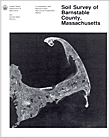The following is a map unit description from the "Soil Survey of Barnstable County, Massachusetts (Fletcher, 1993)"

WvA-Walpole sandy loam, loamy substratum, 0 to 3 percent slopes. This very deep, nearly level, poorly drained soil is in depressions, at the base of swales, and in low areas of glacial lake deposits bordering streams, ponds, and swamps. It makes up about 0.2 percent (461 acres) of the survey area. It is mapped mainly in the Plymouth-Eastchop-CarverBoxford general soil map unit. Areas are irregular in shape and range from 5 to 100 acres in size.
Typically, the surface is covered by a layer of loose, undecomposed leaves and twigs about 1 inch thick. The surface layer is black, friable sandy loam about 9 inches thick. The subsoil is about 13 inches thick. It is mottled and friable throughout. The upper 5 inches is light olive brown sandy loam, the next 4 inches is olive brown sandy loam, and the lower 4 inches is olive gray fine sandy loam. The substratum extends to a depth of 65 inches or more. It is mottled throughout. It is yellowish brown, loose coarse sand in the upper 15 inches and light olive brown, firm silt loam in the lower part.
Included with this soil in mapping are small areas of Amostown, Maybid, Pipestone, and Scitico soils and some areas where the soil is underlain by sandy and gravelly material below a depth of 65 inches. Included soils make up about 30 percent of this unit.
Permeability is moderately rapid in the subsoil of the Walpole soil. It is very rapid in the sandy strata in the substratum and slow or very slow in the silty or clayey strata. Available water capacity is moderate. A seasonal high water table is at or near the surface in late fall, in winter and spring, and after periods of heavy precipitation.
Most areas are used as woodland or support shrubby vegetation.
This soil is poorly suited to cultivated crops because of the wetness, which limits the choice of crops. Diversions and drainage systems help to remove excess water. Incorporating grasses and legumes into the cropping system and mixing crop residue and manure into the surface layer improve tilth.
This soil is poorly suited to hay and pasture. The grasses and legumes that can withstand wetness should be selected for planting. The main management concern is the prevention of overgrazing, which reduces the hardiness and density of desirable plants. Proper stocking rates, timely grazing, and restricted use during wet periods help to maintain plant density and minimize surface compaction.
This soil is suited to woodland. Poor drainage is the main management concern. Equipment can become mired when the soil is wet. Thinning dense stands to standard stocking levels results in more vigorous tree growth. The most common trees are pitch pine, red maple, tupelo, and redcedar.
The seasonal high water table limits the use of this soil as a site for dwellings or septic tank absorption fields. The slow or very slow permeability in the substratum also is a limitation on sites for septic tank absorption fields. Alternative sites should be selected. In areas where the soil is underlain by sandy and gravelly material excavation to this material helps to overcome the restricted permeability.